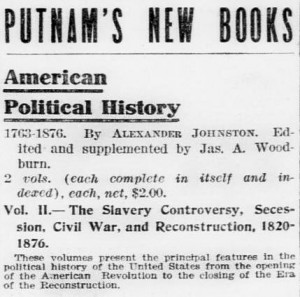Overview
Adopted from: “Reconstruction and the Formerly Enslaved” from National Humanities Center
The aftermath of the Civil War was a crucial period in U.S. history. During this time, the United States began to reconstruct itself by giving slaves freedom, rebuilding public transportation and buildings, and working to unify a divided country. Using the Historic Oregon Newspapers website, students will work with primary and secondary sources that provide a historical walkthrough of the series of events during the Reconstruction.
Oregon Common Core State Standards
Language Arts Standards:
- ELA.RH.6-8.2 Determine the central ideas or information of a primary or secondary source; provide an accurate summary of the source distinct from prior knowledge or opinions.
- ELA.RH.6-8.4 Determine the meaning of words and phrases as they are used in a text, including vocabulary specific to domains related to history/social studies.
- ELA.SL.6-8.1 Engage effectively in a range of collaborative discussions (one-on-one, in groups, and teacher-led) with diverse partners on grade-level topics, texts, and issues, building on others’ ideas and expressing their own clearly.
- ELA.WHST.6-8.2 Write informative/explanatory texts, including the narration of historical events, scientific procedures/ experiments, or technical processes.
- ELA.WHST.6-8.4 Produce clear and coherent writing in which the development, organization, and style are appropriate to task, purpose, and audience.
- ELA.WHST.6-8.8 Gather relevant information from multiple print and digital sources, using search terms effectively; assess the credibility and accuracy of each source; and quote or paraphrase the data and conclusions of others while avoiding plagiarism and following a standard format for citation.
- ELA.WHST.6-8.10 Write routinely over extended timeframes (time for reflection and revision) and shorter timeframes (a single sitting or a day or two) for a range of discipline-specific tasks, purposes, and audiences.
- Additional standards listed in PDF Download
Social Studies Standards:
- Historical Knowledge 8.1 Evaluate continuity and change over the course of U.S. history by analyzing examples of conflict, cooperation, and interdependence among groups, societies, or nations.
- Historical Knowledge 8.2 Evaluate continuity and change over the course of U.S. history, by analyzing key people, the Constitutional Convention, the age of Jefferson, the Industrial Revolution, Westward Expansion, and the Civil War.
- Historical Thinking 8.6 Use and interpret documents and other relevant primary and secondary sources pertaining to U.S. history from multiple perspectives.
- Historical Thinking 8.8 Evaluate information from a variety of sources and perspectives.
- Additional standards listed in PDF Download
Materials
- Historic Oregon Newspapers website
- Access to the Internet
- Worksheets available in PDF Download:
- K-W-L chart (optional)
- Historical Walkthrough activity sheet (optional)
- Big Question activity sheet (optional)
- Timeline material (optional)
Lesson
- Introduction: Engage students’ prior knowledge. You may wish to use a K-W-L chart (one is provided below).
- Transition: Establish the setting of the historical walkthrough.
- It is 1865. The United States is a divided country. President Abraham Lincoln was assassinated in April. The capture of Confederate president Jefferson Davis in May marks a major turning point. The topic of slavery is on everyone’s mind. The accumulation of events up to this point raises some big questions.
- Big questions:
- Who is an American?
- What rights should all Americans enjoy?
- What rights would only some Americans possess?
- On what terms will the nation be reunited?
- What is the status of formerly Confederate states?
- How should citizenship be defined?
- When and how will former Confederates regain their citizenship?
- What form of labor will replace slavery?
- There is an activity sheet provided below for student responses.
- Lesson activity: Hand out historical walkthrough activity sheet.
- The activity sheet’s objective is to lead students through a walkthrough of the Reconstruction period. A lot of information is presented, so make sure to discuss thoughts and initial reactions on what has been read.
- This activity may be done as a whole class or in small groups.
- As students walk through historical accounts of Reconstruction, write down important dates on a timeline that is available to students as reference for later activities.
- Additionally, encourage students to take notes and note initial responses.
- Debrief: Bring students together to discuss their thoughts and reactions to Reconstruction.
- Revisit the big questions.
- Some debrief questions to consider:
- Do you think Reconstruction rebuilt our country?
- Do you disagree or agree with all the amendments that were passed?
- What are your initial reactions to what we have just read?
- What was the most interesting thing you read?
- What are some notes that you have written during our walkthrough?
Extension Activity Ideas
- Letter: Have students write a letter expressing their views on Jim Crow laws.
- Do you agree or disagree?
- What changes would you make to the laws?
- Create a poster to describe the changes.
- Reconstruct Reconstruction: Have students design their own form of Reconstruction. What improvements would they make, and what bills would they pass to make these changes?
- Students may wish to present their amendments to the class.
- Students may vote on which amendments most interest them.
- Essay prompt: After the debrief session, assign students an essay prompt in which they can write a reflection on what they have learned, insights, initial reactions, etc. Or assign the question, “What would you differently during the Reconstruction period?”
- Assign the essay after the class has had time to debrief and discuss their findings.
- Give students the opportunity to present their essays.


Leave a Reply